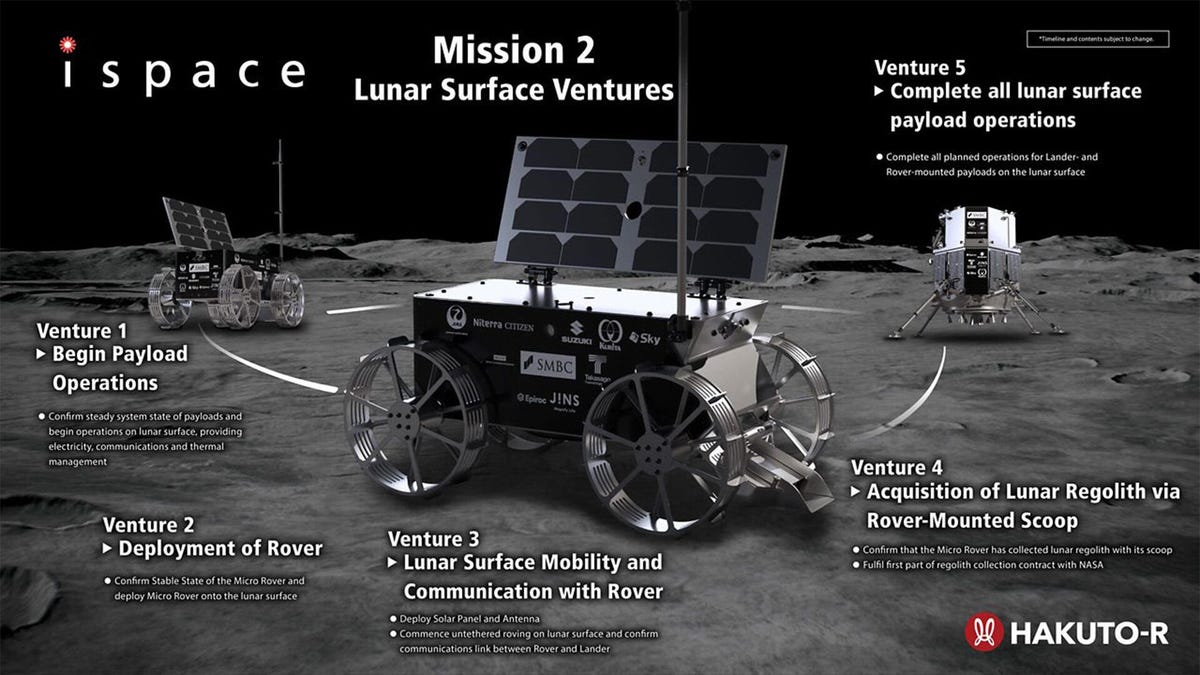Space fans won't have to wait long for major launches to begin in 2025. NASA is kicking off the new year with a big mission to the moon. The upcoming mission includes the Blue Ghost lunar lander from Firefly Aerospace and the Tenacious lunar rover from Japanese company ispace and is part of NASA's Commercial Lunar Payload Services program.
Blue Ghost's primary mission is research. The lunar lander will launch and spend its first 8 hours making sure all its systems are working. From there, it will hover in Earth's orbit for 25 days taking measurements and waiting for the right moment to hurl itself at the moon. After four days in transit, Blue Ghost will spend 16 days in lunar orbit to collect more data before descending to Great Crisisone of the largest basins on the moon.
Blue Ghost's mission plan shows orbits around Earth and the moon before landing on the moon's surface.
Once there, it will spend one lunar day — which is about 14 Earth days — measuring 10 NASA payloads. The instruments will measure subsurface thermal data, radiation levels and other details of the planet. It will also measure regolith, which is the loose dirt and sediment that often resides on airless planetary bodies like the moon. The regolith research will aid dust mitigation in future lunar missions.
At the end of its mission, Blue Ghost will take several pictures of the lunar sunset as night falls. The lander is not scheduled to return to Earth, so once night falls, the lander will have approximately 5 hours to perform its final actions before going offline. Firefly Aerospace says that should be more than enough time to take photos of the sunset and beam them back to Earth. Once it's offline, that's the end of the story for Blue Ghost.
The Tenacious mission plan is that it will have a rendezvous with the Hakuto-R lunar lander before carrying out its tasks.
Along with Blue Ghost, NASA will send ispace's Tenacious lunar rover on the surface of the planet. It's one of the smallest planetary rovers ever designed, and it wouldn't look out of place on one RC car toy store Stands tall at 26 centimeters (10 inches) and weighs only 5 kilograms (11 pounds).
Being patient is part of Resilience's second mission. The first mission took place in 2022 with a similarly small Hakuto-R lander.
Tenacious will launch with Blue Ghost, then Tenacious will land at the mouth of the Atlas at Mare Frigoris and establish a connection with the Hakuto-R lander. That's how data gets back to Earth.
Tenacious will use its equipment to conduct food production experiments, detect radiation, perform water electrolysis and collect regolith.
When will Blue Ghost and Resilience launch?
says NASA the launch is slated for a six-day window in mid-January, but exact dates have yet to be confirmed.
Once the launch happens, it will take off from Launch Complex 39A at the Kennedy Space Center in Florida. SpaceX will provide a Falcon 9 Block 5 rocket for the launch.
Can I stream the launch of Blue Ghost and Resilience?
Yes. A representative for NASA told CNET that the launch will be streamed live. No official announcement has been made yet but keep an eye out The upcoming NASA events page for more details as they are announced. We'll update this article when we know more.
What are mission payloads?
In total, there will be 15 total payloads — the elements of the spacecraft dedicated to producing and transmitting mission data — to the moon. Five of them will go with Tenacious and 10 will go with Blue Ghost.
Blue Ghost payloads:
-
Lunar Instrumentation for Subsurface Thermal Exploration with Fast (LISTER) from Honeybee Robotics
-
Lunar PlanetVac (LVP) from Honeybee Robotics
-
Next Generation Lunar Retroreflector (NGLR) from the University of Maryland
-
Regolith Adherence Characterization (RAC) from Aegis Aerospace
-
Radiation Tolerant Computer (RadPC) from Montana State University
-
Electrodynamic Dust Shield (EDS) from NASA Kennedy Space Center
-
Lunar Environment heliospheric X-ray Imager (LEXI) from Boston University, NASA Goddard Space Flight Center, and Johns Hopkins University
-
Lunar Magnetotelluric Sounder (LMS) from the Southwest Research Institute
-
Lunar GNSS Receiver Experimental (LuGRE) from the Italian Space Agency and NASA Goddard Space Flight Center
-
Stereo CAmera for Lunar Plume-Surface Studies (SCALPS) from NASA Langley Research Center
Resilience payloads:


